
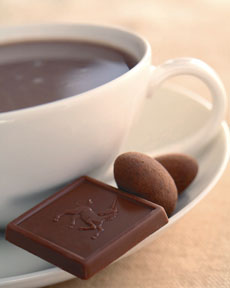
A palet, or napolitain, is a small square of chocolate meant to accompany a cup of espresso or other beverage (like the hot chocolate shown above).
March 2005
Last Updated November 2025
|
 |
Chocolate Glossary
Chocolate Terms & Definitions: N & O
On this page, you’ll find terms including Nacional cacao, natural cocoa, nib, nougat, and ocumare. If you think we should consider chocolate terms and definitions other than those we have provided, click on the Contact Us link on this page. Also enjoy our 100+ other food glossaries.
Use this index bar to visit other pages.
a b c d e f g h i j k l m n o p q r s t u v w x y z
This glossary is protected by copyright and cannot be reproduced in whole or in part.
NACIONAL or ARRIBA NACIONAL CACAO
Nacional cacao is predominantly grown in Arriba Mocache, Los Rios, Ecuador, with some stock grown in Colombia. Overall, it is a cacao that shares the hearty flavor of Forastero and the nuances of Criollo, and could be viewed as the best of both worlds. Some people consider it a Forastero, while others argue that genetically it’s a fourth subgroup of cacao altogether—it has the same fragility and high disease susceptibility as a Criollo. It is regarded as a flavor cacao, though not quite as delicate or fine as Criollo. Typical Nacionals possess a delicate cacao flavor, accented by a perfumed floral scent and lovely floral tones, including a dominant jasmine note and nutty after-tones. However, others can be quite hearty and bear flavors of coffee, vanilla, soft red fruits, and spice. Unlike most Forasteros, which can be harsh and bitter, the bitterness level of these beans is practically nil—its flavor is smooth, which further adds to its unique character. In fact, it is a “sweeter” bean, and in higher percentage cacao products—75% and up—it produces a sweeter, smoother chocolate given the same amount of sugar as a different bean.
NAMA CHOCOLATE
Nama chocolate is a very soft chocolate ganache made with high‑quality chocolate mixed with fresh cream (and sometimes a bit of liqueur). It’s set in a slab, cut into small cubes, and dusted with cocoa powder. Nama means raw or fresh in Japanese, referring to the fresh cream.
Most sources concur that it was invented in 1988 by chocolatier Masakazu Kobayashi, owner‑chef of Sils Maria, a confectioner’s shop in Kanagawa, Japan. He named his new style of very soft chocolate ganache Nama Chocolate or “Nama Choco” for short. This is widely cited as the birth nama choco (nama chocolate).
In 1993, Kobayashi worked with a major confectionery company, Meiji, to launch Meltykiss, a nama‑like chocolate. It was sold only in winter because it melts easily at room temperature. Meiji popularized the nama style across Japan.
Another large company, Hokkaido‑based chocolate maker ROYCE’, introduced its nama chocolate line in 1995–1996. These boxed chocolates—kept chilled and often bought as souvenirs at airports—became the best‑known version internationally. It has become the signature product of ROYCE’ (the apostrophe is a stylistic choice of the company).
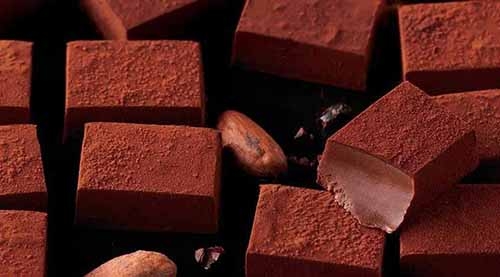
Nama chocolate (photo © Royce Chocolate).
NAPOLITAIN or PALET or TASTING SQUARE
A sample-size portion of bar chocolate, individually wrapped. The typical napolitain is a five to 10 gram square.
NATURAL PROCESS COCOA or NATURAL COCOA POWDER or NON-ALKALIZED COCOA
Cocoa in its natural state, that is not dutched—i.e., it is cocoa processed without an alkaline treatment. Early chocolate was mostly consumed in a liquid form as a drink. Cocoa butter was originally removed from chocolate by boiling and skimming until the early 1800s, when Dutch chemist Coenrad van Houten developed a hydraulic press to remove the cocoa butter and produce cocoa. There were two problems with this early cocoa: it didn’t easily mix with water, and it had an acidic taste. So van Houten treated the powder with alkaline salts (potassium or sodium carbonate). The process became known as Dutch-processed cocoa.
|
|
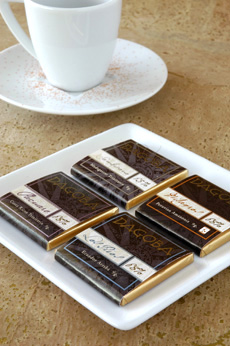
Palets from Dagoba Organic Chocolate. Photo by Dhanraj Emanuel | THE NIBBLE. |
The process darkens the color and eliminates the acid notes. Natural cocoa powders are usually yellowish-brown in color and have a fruity flavor with an acidic backbone. Their sharper flavor may give certain recipes a slightly harsher taste, but generally, it is not very noticeable. When added as an ingredient to various recipes, it will add a pale brown color to the food. Dutch cocoa powder, on the other hand, provides a richer flavor and a deeper brown coloring to the food or beverage. As recipes are prepared using one or the other, it is generally best not to substitute natural process cocoa for Dutch unless baking powder or baking soda is added to the recipe. In a top-quality cacao, it may not be necessary to Dutch the cacao to remove the acid, whereas in an average-quality cacao, it is.
|
NIB, KERNEL, or MEAT
The interior meat of the cacao bean. The nib is retrieved after the beans are roasted and the husks are removed. The nibs themselves are more than 50% fat (cocoa butter): nibs from fine beans have 53% or more. While nibs are ground and conched to make chocolate, they are also roasted and sold as crunchy confections, plain and chocolate-covered; for use in desserts, for savory uses in salads and sauces, and as garnishes. A number of chocolatiers make bars with nibs.
|
|
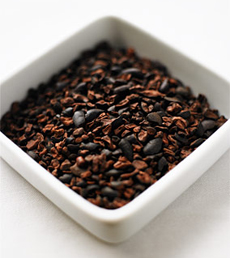
Cacao nibs. Photo courtesy Theo Chocolate,
a NIBBLE Top Pick Of The Week.
|
NOUGAT
A stiff and chewy confection made of whipped egg whites, honey, and sugar, to which nuts (commonly almonds, hazelnuts, or pistachios), and sometimes candied citrus zest, are added. Creative confections can add dried fruit, lavender, and other flavor elements. Chocolate nougat has chocolate added. Nougat can also be dipped in chocolate (i.e., chocolate-covered). Nougat is a French word; torrone is the Italian word.
|
|
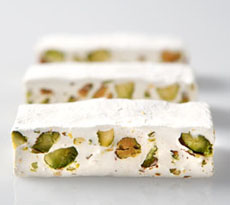
Nougat from PistachiaVera.com.
|
NOUGATINE or CROQUANT
A confection like brittle, made of hard crystallized/caramelized sugar to which ground almonds are typically added. Crushed nougatine pieces are used as filling in certain chocolates and chocolate bars.
NUT
The cacao pod. Also called the cabosse.
OAXACA CHOCOLATE
A chocolate made in Oaxaca, Mexico. See Mexican chocolate.
OCUMARE 61 and OCUMARE 67
Criollo and Trinitario hybridized blends originally from the Ocumare de la Costa valley of Venezuela. Ocumare 61 has a sharp punch. Flavors vary, but earthy spiciness, peaches, red fruits, and fresh dairy are common. Ocumare 67 is darker in tone, more robust and assertive, and lacks 61’s sharpness. Flavor notes include cashews, peanuts, spice, pepper, and sometimes dairy.
1ER CRU CHOCOLATE
An abbreviation for premier cru chocolate.
ORGANIC
Organic refers to how foods and other products are produced. Organic production is 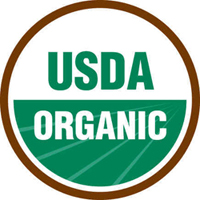 based on a system of farming that maintains and replenishes the fertility of the soil and the health of plants, animals, and people. Organic foods are produced without the use of chemical pesticides and fertilizers and are processed without artificial ingredients, preservatives, or irradiation. Organic chocolate contains a minimum of 95% naturally grown and certified raw materials. Organics produced in the United States are under the authority of the Organic Foods Production Act, and can apply for official certification. Read more about organic product certification, the issues surrounding organic chocolate, and our favorite organic chocolate. based on a system of farming that maintains and replenishes the fertility of the soil and the health of plants, animals, and people. Organic foods are produced without the use of chemical pesticides and fertilizers and are processed without artificial ingredients, preservatives, or irradiation. Organic chocolate contains a minimum of 95% naturally grown and certified raw materials. Organics produced in the United States are under the authority of the Organic Foods Production Act, and can apply for official certification. Read more about organic product certification, the issues surrounding organic chocolate, and our favorite organic chocolate.
ORIGIN CACAO or ORIGIN CHOCOLATE
See single-origin cacao.
Continue To Next Page: Terms With P
Go To Article Index Above
Lifestyle Direct, Inc. All rights reserved. Images are the copyright of their respective owners.

|







 based on a system of farming that maintains and replenishes the fertility of the soil and the health of plants, animals, and people. Organic foods are produced without the use of chemical pesticides and fertilizers and are processed without artificial ingredients, preservatives, or irradiation. Organic chocolate contains a minimum of 95% naturally grown and certified raw materials. Organics produced in the United States are under the authority of the Organic Foods Production Act, and can apply for official certification. Read more about
based on a system of farming that maintains and replenishes the fertility of the soil and the health of plants, animals, and people. Organic foods are produced without the use of chemical pesticides and fertilizers and are processed without artificial ingredients, preservatives, or irradiation. Organic chocolate contains a minimum of 95% naturally grown and certified raw materials. Organics produced in the United States are under the authority of the Organic Foods Production Act, and can apply for official certification. Read more about